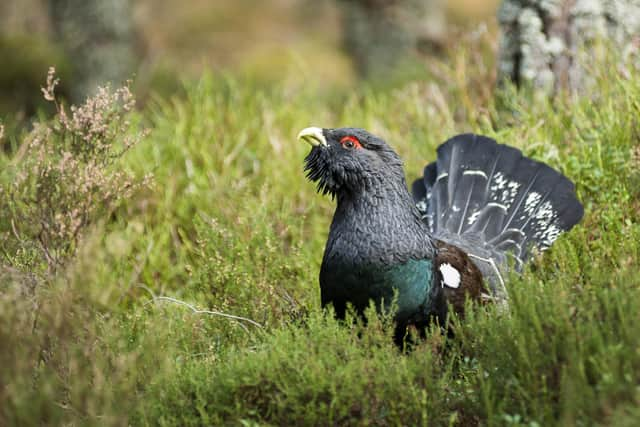Extinction clock ticking for the capercaillie with less than 500 in the wild, warn experts
Capercaillie numbers have been falling for decades and despite repeated attempts to boost the population it can now only be found in the Highlands.
Experts from the Game & Wildlife Conservation Trust (GWCT) said that when surveys started in 1991, capercaillie numbered approximately 2,200 birds, spread from Argyll and Perthshire to the south and west Aberdeenshire in the east and Ross-shire in the north.
Advertisement
Hide AdAdvertisement
Hide AdHowever, by 2017 a nationwide survey revealed the downward trend had continued to a new low of just 1,114 individual birds.


Now, the GWCT say perhaps only 300 - 400 birds remain, with 90% confined to one area of Strathspey in Inverness-shire.
GWCT has demanded a new policy and practical action to save the famously ill-tempered bird, whose Gaelic name translates as the “Horse of the Woods”.
The world's largest grouse was reintroduced to Scotland in 1837 from Swedish stock after becoming extinct the previous century.
After a promising start, it is now on the “red-list” of species of highest conservation concern.
The GWCT say the bird is now "living in fragments" of the once widespread Caledonian Forest, where it is in "severe trouble".
The sharp decline is largely due to fewer chicks hatching and a reduced survival rate of those which do break out of their shells.
In August, the GWCT completed its 33rd consecutive year of capercaillie brood surveys and it discovered "a continued decline in breeding success over time".
Advertisement
Hide AdAdvertisement
Hide AdGWCT research has shown that capercaillie breed better in years when June weather is dry and warm, and in forests where predators such as carrion crow and pine marten are fewer.
Despite this year’s good weather, the survey found only 0.4 chicks fledged per female, below the 0.6 chicks needed to maintain numbers.
Despite well-intentioned conservation programmes to improve capercaillie habitat, extinction "seems likely within the next 30 to 50 years", it said.
Earlier this year, scientific advisors to NatureScot reviewed causes of decline and urged four immediate management actions.
They recommended culling foxes and crows and translocating legally protected pine marten from capercaillie forests.
Dr David Baines, GWCT’s head of upland research, said: “The end is nigh for capercaillie unless we quickly turn around the low chick survival. Pine martens have increased in recent decades and are known to consume capercaillie eggs and chicks. Their licensed removal from key capercaillie strongholds is urgently required to help avoid species extinction.”
The capercaillie is the world’s largest grouse. Males - with their slate grey plumage, blue sheen head and bright red eye ring - can reach around 90cm in length and 14lbs in weight. Females are smaller with brown and chestnut-red feathers and fan-shaped tail.
In spring they gather at communal “leks” where the males perform courtship displays in the hope of attracting a mate.
Advertisement
Hide AdAdvertisement
Hide AdWill Anderson, chief executive of Seafield and Strathspey Estates who hosted this year’s survey added: “We have been managing and extending our forests to benefit capercaillie for over 30 years and it would appear that neither habitat extent nor quality is limiting their numbers. We are concerned that in a year where weather is also unlikely to be a limiting factor, we have such poor brood numbers.
Comments
Want to join the conversation? Please or to comment on this article.